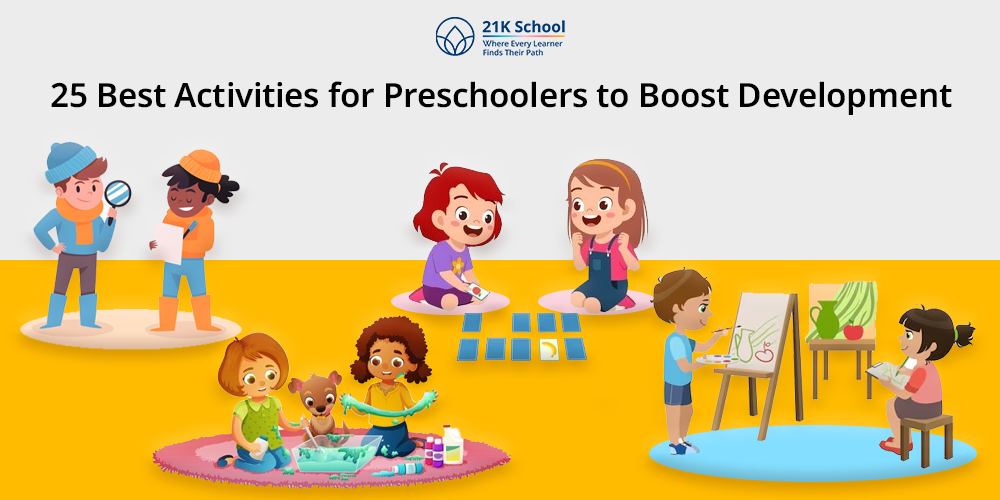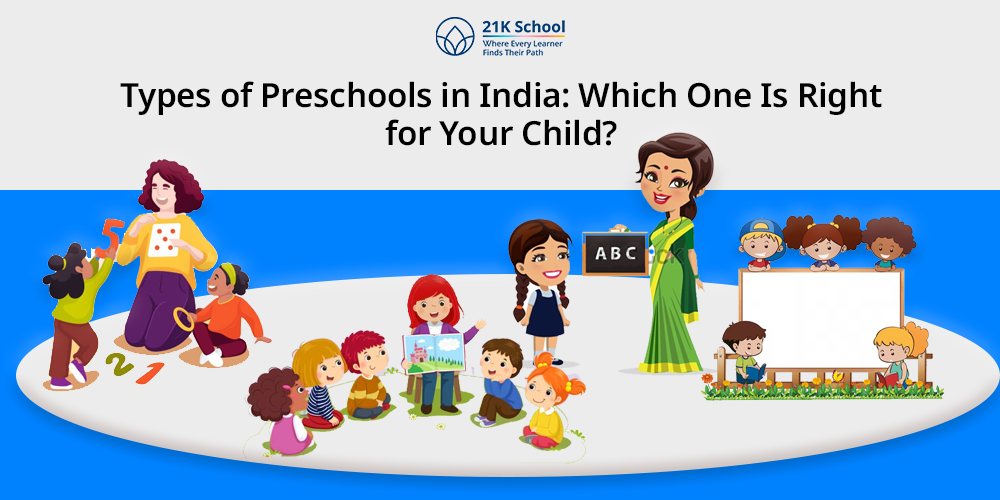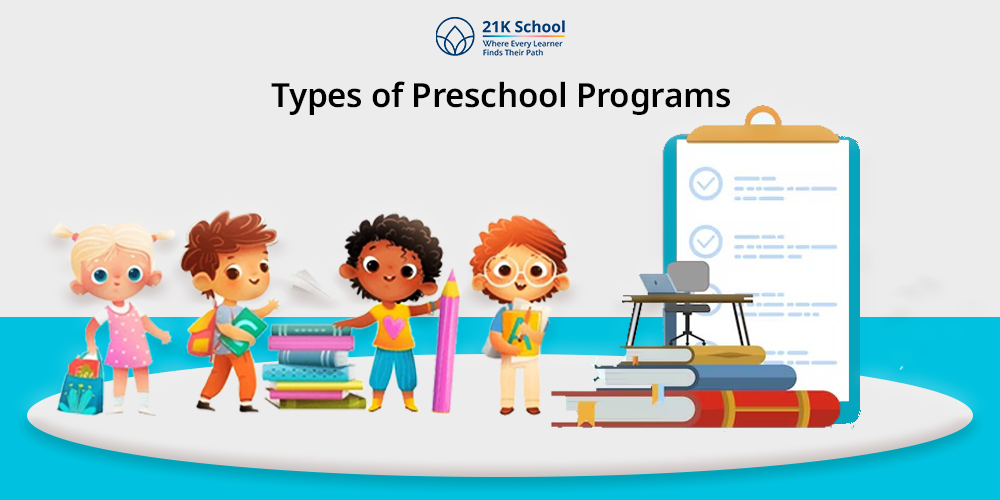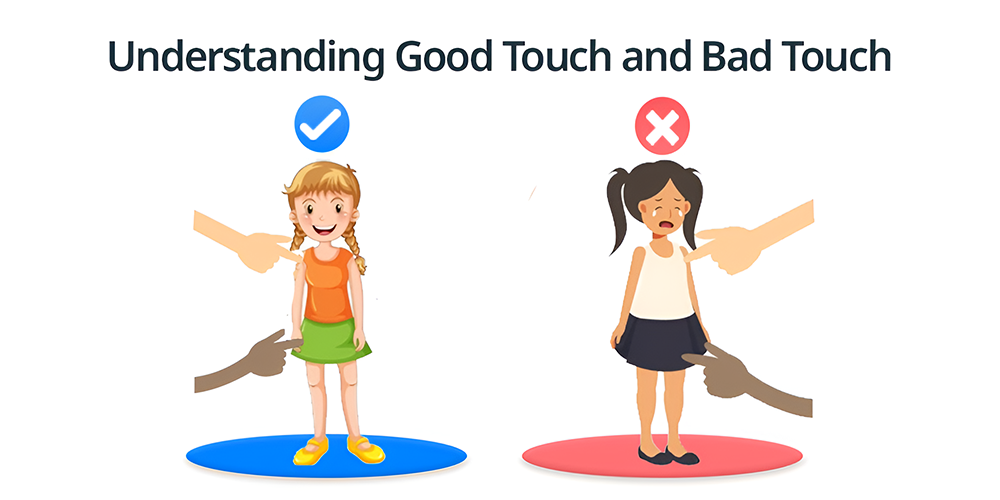
Life can be very unpredictable and sometimes the world feels overwhelming especially when you are concerned with the safety and well being of your children. It is one of the most critical responsibilities that a parent or guardian has to take care of.
One of the most important and sensitive topics to address is the concept of good touch and bad touch.
This is something that is yet to be normalised by people and parents have to understand that it is very important to teach this concept to people and young children to understand the difference not only to protect them but also to empower them.
When a child understands the difference between good touch and bad touch they tend to protect themselves from the external threat and all the possible harm.
It helps them have a proactive approach to things along with which it also empowers them to set personal boundaries for themselves which makes them feel a sense of confidence in their ability to speak up for themselves.
Contents
What Is a Good Touch?
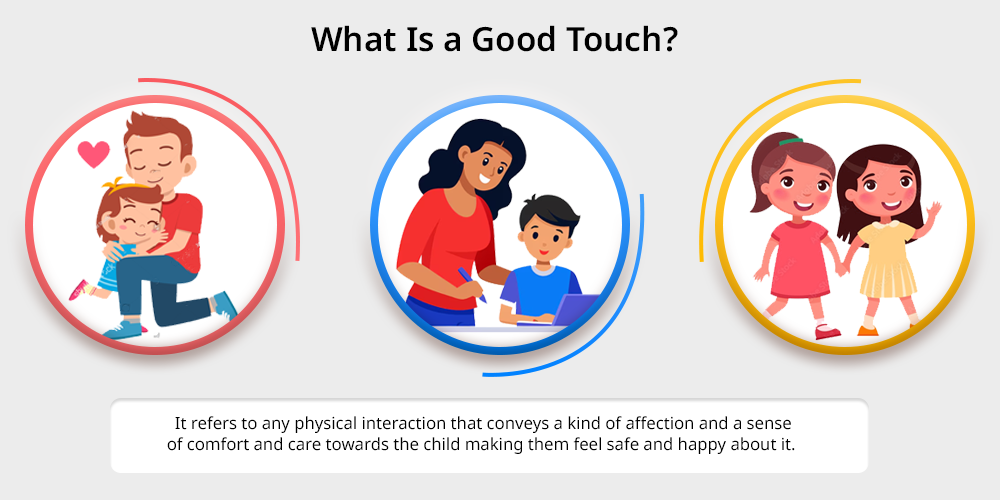
Good touch just goes by the name. It’s good.
It refers to any physical interaction that conveys a kind of affection and a sense of comfort and care towards the child making them feel safe and happy about it.
For example when a parent hugs their children or a teacher pats on their back. You can also include a situation where a friend is holding their hand to guide them or to participate in any co-curricular activity.
These comfortable touches often come from people who are a child known or trust worthy members of a child’s close circle.
These judges are meant to express different forms of love, encouragement and support to children.
When a parent, teacher or a guardian is teaching children about good touch it is very important to emphasize on these interactions appropriately only when they feel comfortable about it and not to force them to understand this concept.
To break it in simple terms it is very important to understand that a child may enjoy being hugged for a certain amount of time after that they might not and that’s okay. Similarly a child may enjoy being hugged and another child might not and it’s completely okay to feel that way.
It is also important to acknowledge their preferences and consider their boundaries. It helps them in being confident about their life choices and helps in being expressive.
What Is Bad Touch?
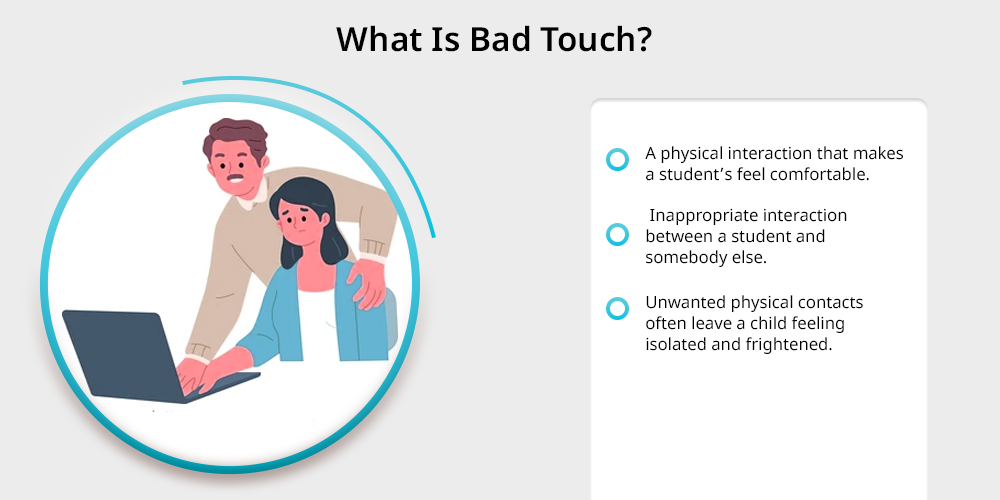
Bad touch, on the other hand is a physical interaction that makes a student’s feel comfortable they are scared of these interactions or may often be seen as a confused response to the situations.
Any such circumstances could involve all the inappropriate gestures and prolonged or unwanted physical contact coming from known or unknown people. It is an action that invades their personal space in a harmful way.
It is an inappropriate interaction between a student and somebody else where a bad touch is often accompanied by secrecy, threats and coercion.
These unwanted physical contacts often leave a child feeling isolated and frightened of the environment.
It is a very critical element of a situation where it is important to understand that a bad touch is about Instinct and parents should teach children to trust their instincts and speak about it whenever they don’t feel right.
It is the parents and guardians responsibility to tell their children that It’s okay to stand for your right even if it is coming from someone they know.
They should feel empowered to say no and move away from the situation to see help from a trusted adult in such a situation.
Why Is It Important to Teach About Good Touch and Bad Touch?
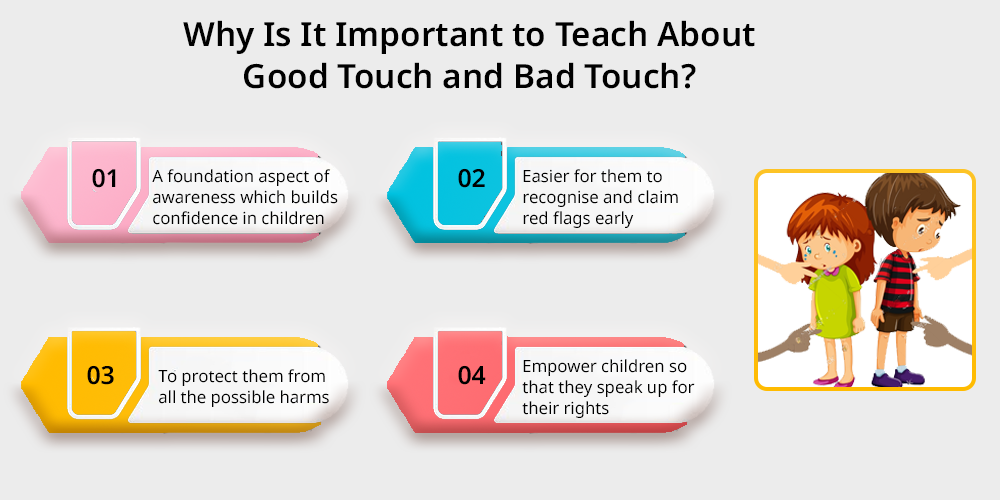
It is very important to teach children about good and bad and it is not just something that will happen in one conversation, rather it requires patience and time.
It is a foundation aspect of awareness which builds confidence in children to navigate through the world better and build more conscious relationships in future.
It is important to teach these things to children to protect them from all the possible harms as children are vulnerable.
And predators often exploit their innocence which is brutal and inhuman.
By teaching children about these things it will be easier for them to recognise and claim red flags early, reducing the risk of falling victim to such abuse.
It is to empower children so that they speak up for their rights and their experiences.
Many abuses can go unreported because the child has been silenced by fear, confusion or even in such cases for shame.
For a small average middle class home it is a taboo to point out such topics and have a conversation.
This hierarchy of taboo and unreported exploitation should now stop and this only happens if we empower our children with the knowledge of good and bad touches.
This will help children in building confidence to voice out their concerns more confidently.
Teaching them about good and bad touch will build awareness about personal boundaries in children which is an essential life skill for them to grow into a world full of connections and relationships.
It will help children in understanding their rights to their body and create a sense of autonomy and self respect in them.
Signs a Child Might Be Experiencing Bad Touch
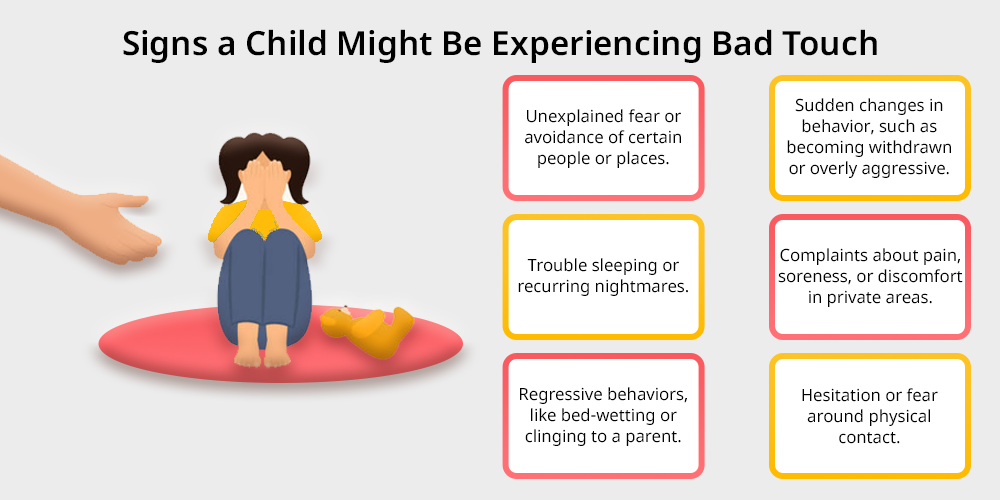
Even after being in a comfortable and quiet environment children may not always be able to communicate directly about such experiences related to bad touch it is very crucial for adults to stay very observant of the environment and look for common signs that may include:
- Unexplained fear or avoidance of certain people or places.
- Sudden changes in behavior, such as becoming withdrawn or overly aggressive.
- Trouble sleeping or recurring nightmares.
- Complaints about pain, soreness, or discomfort in private areas.
- Regressive behaviors, like bed-wetting or clinging to a parent.
- Hesitation or fear around physical contact.
If parents, guardians or any caretaker notices these signs it is suggested for them to approach the child very gently (never rush in such situations as it can lead to withdrawals) and create a space for them which is safe for sharing their feelings without any fear of judgement or punishment.
How to Teach Children About Good Touch and Bad Touch?
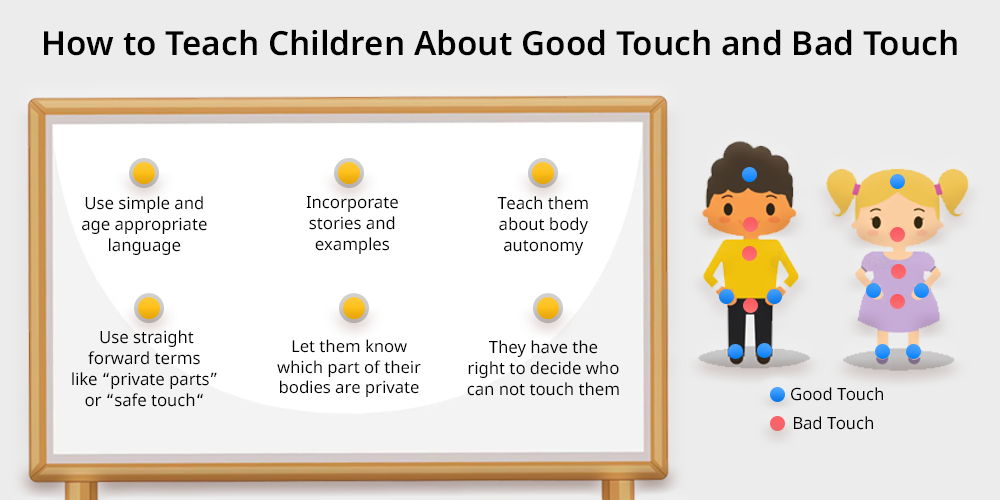
Discussing good touch and bad touch with children does not have to be very intimidating, rather it can have an approach which is very convenient for them and is not very complicated for them to understand.
This can be facilitated by a situation where parents can use simple and age appropriate language to avoid any complication and abstract explanation.
It is suggested for them to use straight forward terms which are easier for them to understand like “private parts” or “safe touch“.
Parents and other stakeholders can also incorporate stories and examples in between their conversation to make it more relatable for them where it will be easier for children to grasp these concepts more effectively.
They can even teach them about body autonomy before having this conversation which will explain to them that their body belongs to them and they have the right to decide who can not touch them.
It is one of the basic things that a student needs to know at the very beginning of their life and understand that not every touch is as comfortable and human as their parents and close family members.
Parents and guardians can establish clear rules letting their children know which part of their bodies are private and can emphasize on the concept that no one is allowed to reach out except for some selective people in specific circumstances.
All of these things will only be effective if they are involved in open communication which assures children that they can always talk about their concerns, issues and doubts regarding any of such discussion to you or to any other trusted adults in case something doesn’t feel right.
Tips for Parents, Guardians, and Educators
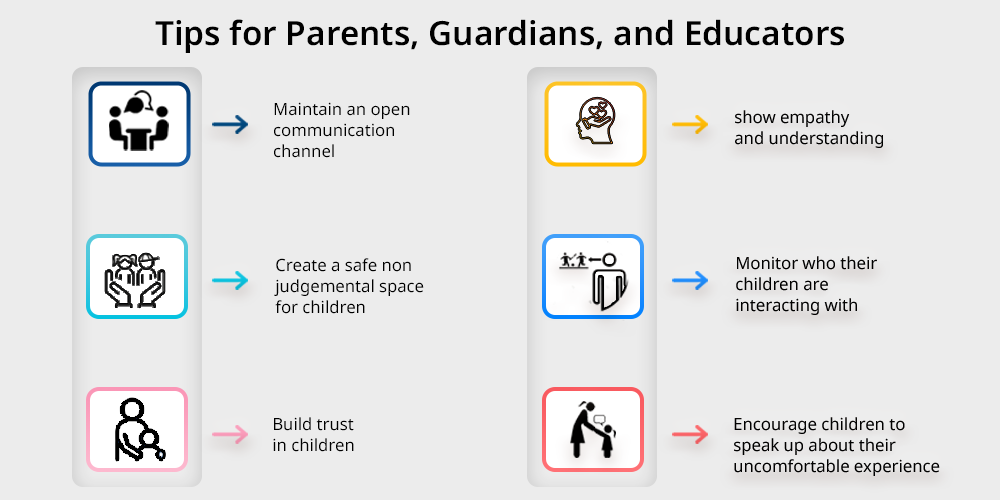
It is a very sensitive topic and requires a lot of patience coming from the parents and guardians side where they have to show a consistent effort to normalise the concept of good touch and bad touch.
Some of the practical tips that parents, guardian and educators can follow are :
Maintain an open communication channel with children and make it a habit to check in about their day on a daily basis.
It is very important for caretakers to create a safe non judgemental space for children which would encourage them to share their experiences honestly.
They can even try to build trust in children so that they feel safe about sharing their concerns with them.
The easiest way to do so is to show empathy and understanding in your interaction with them, so that they know who they are relying on and no matter what they can rely on you.
Parents and bhajans are suggested to monitor who their children are interacting with on a regular basis.
It is very important to be aware of adults and peers in your children’s life to know about any predictable harm.
It is not about being suspicious but it is about being vigilant for their child’s safety.
It is also suggested for all the stakeholders involved to encourage children to speak up about their uncomfortable experience and normalise these topics for them.
By normalising such topics and talking about feelings and experiences they can make an environment for children which is supportive and non judgemental.
It is also important to let them know that it’s very much ok to say no to any kind of uncomfortable interactions even to adults and it will not be considered rude or unethical in any circumstances.
Conclusion
Teaching children about good touch and bad touch is not the most meaningful way to teach them and empower them to protect themselves in a situation where harm can be foreseen.
It is not about just preventing harm, it is about empowering them and equipping them with all the tools that are needed to navigate through a relationship which they will build in future to set boundaries and respect themselves.
These conversations can be challenging but they are investment from a child’s future and well being perspective and there is no appropriate age to start these conversations.
It is very important to teach students and normalize the concept of talking about their feelings and experience when being uncomfortable.

